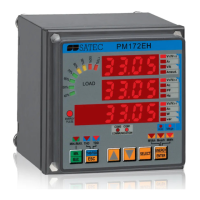8
within the following 65535 logs. If a record is missing because of a communication problem, the read sequence
for the log can be restored from the record with the desired sequence number.
Accessing Log Files
Each log file has a separate file read pointer which always points to the current file record that will be read next,
and a separate register window which gives access to the record pointed to by this pointer. Initially, the read
pointer is associated with the oldest record in the file. Reading a record via the file window returns the current
record data, and then the pointer automatically advances to the following record in the file. Consequent requests
addressed to the file window will return a new record each time in the direction from the oldest record to the more
recent records. Because the file window advances automatically after the instrument responses to the master
request (disregarding of the number of registers in the window being accessed), the entire window must be read
at once using a single request.
The instrument provides circular file reading, i.e., after the last record has been read, the file read pointer is
automatically shifted to the beginning of the file. File read requests always allow you to read the entire log file
disregarding of the current file status. You can simply poll the file window registers just as you poll ordinal data in
your SCADA applications, without the need to manipulate with the file pointer. Refer to Sections 5.14, 5.15 and
5.16 for information on registers you can use to access your log files.
A log file can be read both in an arbitrary order and in sequence as explained above. To access the log records in
a random order, the file read pointer can be re-written with the desired sequence number to point to the desired
record. Refer to Sections 4.7, 5.12 and 5.13 for information on how to check the log file status and how to re-write
the file read pointer. Writing to the memory partition command register (see Section 5.13) allows you to force the
file pointer to point to the oldest record in the file or to the first new record in the file that you have not yet read.
You can also use the instrument reset registers (see Sections 4.3 and 5.11) to restore the file read pointer to the
oldest record in your log file if you want to re-read the file from the beginning.
IMPORTANT: Take into consideration the fact that in a wrap-around (circular) log partition, the oldest records may
be overwritten by the most recent records since you have read either log status register. An attempt to point to the
particular record directly by using its sequence number may fail if the addressed record has just been overwritten.
3.4 Password Protection
The PM172EH has a password protection option allowing you to protect your setups, cumulative registers and
logs from being changed or cleared through communications. You can disable or enable password protection for
communications via the front panel. For details, refer to your instrument Installation and Operation Manual. When
password protection is enabled, the user password you set in your instrument should be written into the
communications password register (see Section 5.20) before another write request will be issued. If the correct
password is not supplied while password protection is enabled, the instrument will respond to all write requests
with the exception code XM (illegal operation). It is recommended to clear the password register after you have
completed your changes in order to activate password protection.

